
Hidden Jordan: exploring Jordan’s nature reserves and panoramic hikes
Despite being blanketed in desert, Jordan is emerging as a popular destination for active holidays. Far from being an inhospitable environment, the desert landscapes offer almost otherworldly scenery – much different to what we are used to experiencing in Europe. To see the country in all its natural glory, it’s best to escape the confines of air-conditioned cars and hotels and explore on foot; not only will you get to discover some of the country’s most recognisable highlights, such as the Mars-like panoramas of Wadi Rum and the rosy-tinted sandstone palaces of Petra, you’ll also get to enjoy its unspoilt nature reserves.
Much of the country’s wild places have been preserved by the Royal Society for the Conservation of Nature; the organisation was founded in 1966 and got a head-start on conserving Jordan’s ecological heritage compared to many of its neighbours. In recent years, walking holidays in Jordan have become so popular that the non-profit Jordan Trail Association launched the Jordan Trail in 2017 – an overland hike that covers around 600 kilometres of footpaths between the northern border with Israel and the coastal resort of Aqaba in the south. This adventure is on the epic end of the scale – think 35 to 40 days on average to cover the distance, if you’re walking a bit every day. But there are a vast number of options if you don’t have months to spend on an adventure, and you can even take in parts of the newly-inaugurated trail.
Tackling Jordan on foot is an immensely rewarding experience: you’ll get to see ancient ruins up close, stroll through the deserts, descend into towering canyons, and meet the warm and welcoming people along the way – you may even get to share a cup of sweet mint tea with a Bedouin family. Whether you are looking to plan a thrilling point-to-point adventure or simply work a shorter day hike into a Jordan trekking holiday, here are some of the beautiful nature reserves and panoramic hikes you can see along the way.
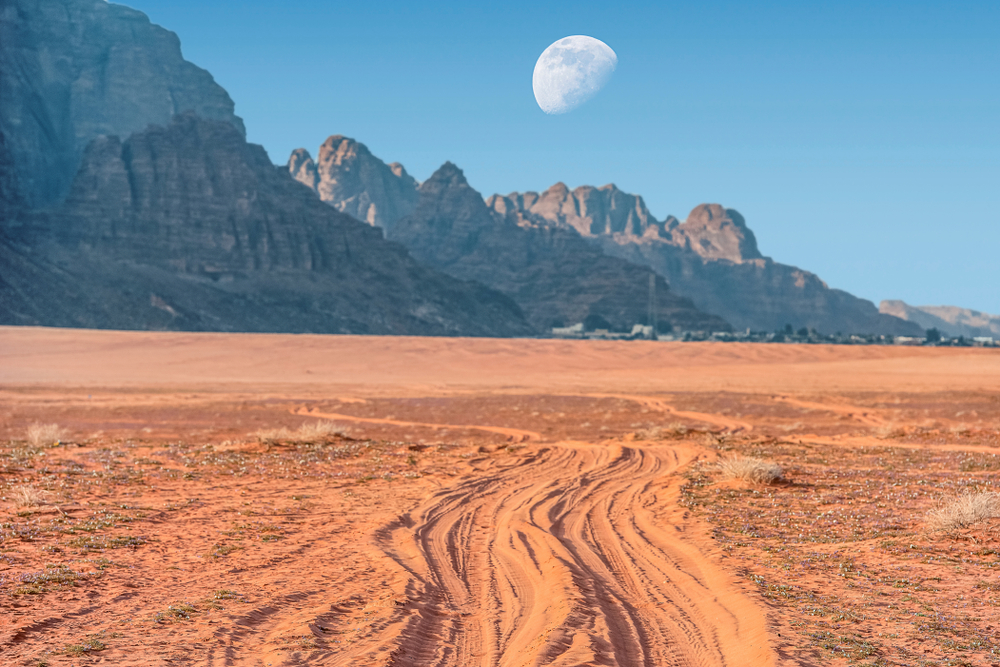
What can you see on Jordan trekking holidays?
Whilst Jordan’s main draw is clearly its historic wonders like Petra and the Crusader Castles, the country is also notable for its rare and elusive wildlife. The regions of Dana and Ajloun are particularly famous for their bird-spotting, as the country is a central hub for migrating species – head to the wetlands of Azraq or Ajloun in the north and keep your binoculars handy. Some of the animals you might spot include Nubian ibex, sand cat and Syrian wolf, and roe deer are often spotted in Ajloun.
Best time for trekking holidays
The temperature in Jordan may rise to dizzying levels in the summer months, when the mercury often reaches 35 to 40 degrees, though the country can easily be explored year-round. However, the best time to visit is in the shoulder season, which sees fewer tourists and more pleasant temperatures – ideal if you’re embarking on Jordan trekking holidays.
We’d recommend the spring months of March to June for Jordan adventure holidays, when the days are warm and the beautiful wildflowers come into full bloom after the winter rains – the canyons are lush and green and many of the trees in the north are heavy with fruit. The countryside is full of lush green grasses and pretty flowers, such as the striking black iris.
It’s also the best time to spot Jordan’s shy residents of the animal kingdom. However, the autumn months of mid-October to December also afford perfect walking conditions, with the scorched colours of summer (just minus the soaring temperatures).
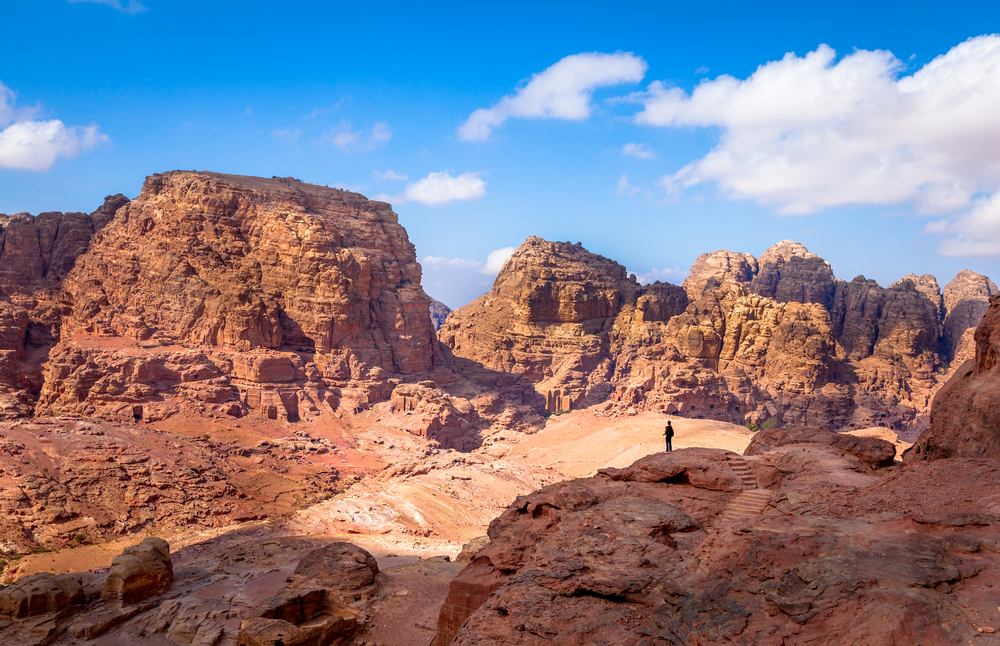
Where to go on Jordan trekking holidays
Walking holidays to Jordan are the ideal way to explore the wilder reaches of the country, heading into the desert landscapes of Wadi Rum and the beautiful, protected scenery of Dana Nature Reserve and some of the country’s less-visited areas.
Wadi Rum
One of the most famous sights in Jordan is surely the tawny dunes of Wadi Rum, where canyons, rock bridges and jaw-dropping formations provide a stunning backdrop. The deep blue skies contrast perfectly with the rich sand which changes colour from palest straw to deepest ochre, depending on the time of day. Hiking in Wadi Rum offers the chance to experience the full-blown desert, striding among towering mountains of rippling sandstone and unbroken dunes, encountering the Bedouin people and camping under a blanket of stars. Walking in the footsteps of Lawrence of Arabia – plus all the other explorers that came before and after him – you’ll discover the human evidence of those who have passed this way, from rock inscriptions to ruins linked to the great Lawrence and his desert fighting force.
One thing you’ll notice while trekking in Wadi Rum is the magnificent silence, just the sound of the wind whistling between the dunes and your footsteps crunching on the sand. After long days of walking you won’t want to travel too far to find a comfortable bed to sleep in, so it’s worth picking one of Wadi Rum’s desert camps. While there are several to choose from, we like Mazayen Rum Camp, which is a great example of Jordan’s famous hospitality. The private tents are furnished with Bedouin-style details and even have their own en-suite bathrooms, plus each tent is elevated off the desert floor on wooden panels, so you won’t find yourself deluged by the sand.
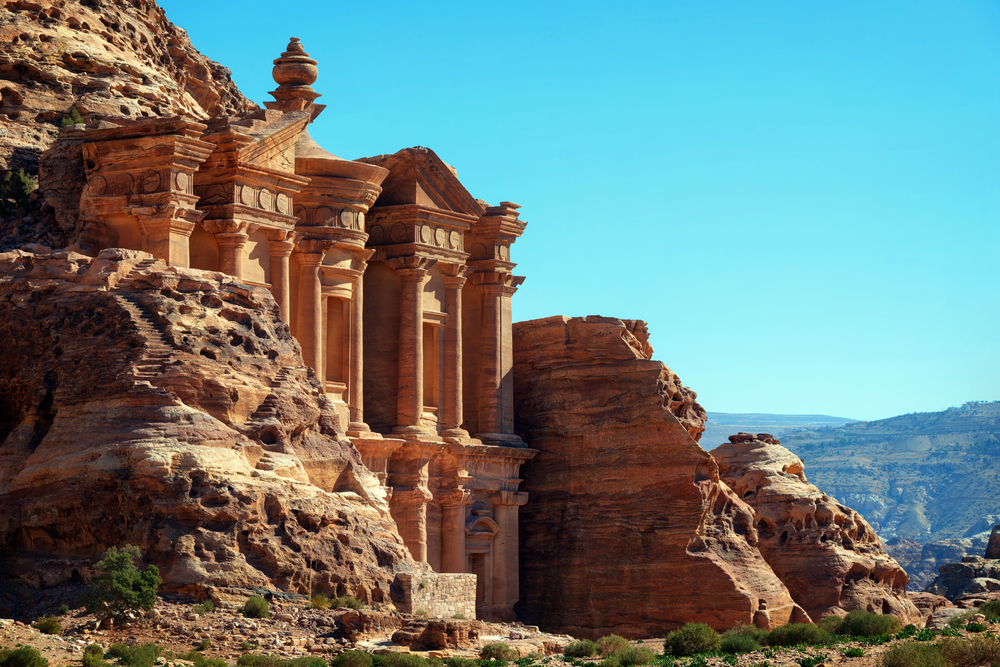
Petra
Perhaps the most enduring image of Jordan is the rose red city of Petra, voted as one of the New Seven Wonders of the World and designated a UNESCO World Heritage Site. You’ll have heard of it as a must-see on your Jordan trekking holiday itinerary, but as well as being a magnificent historical site it’s also a great walking and trekking destination. You can start in the dramatic Siq Canyon, make your way to the stunning Treasury and explore the remains of the Nabataean city, taking in the temples and tombs, before heading to the outer reaches of the site to embark on some truly amazing walks and climbs – the views here are incredible, gazing out over the wind-sculpted sandstone mountains.
Up here, it’s easy to escape the crowds and take in the size of this once-forgotten city. One of the most jaw-dropping routes takes you between Petra and Little Petra, a secondary site a short distance from the main ruin. While the Siq is undoubtedly the most incredible first impression, the route from Little Petra is just as impressive and is worth a walk on your additional days in the area.
The path begins near Little Petra and winds its way up the outside of the mountains which shield the main city from view. The real reward comes when you take in the incredible horizon as you reach the top and the Monastery Tomb, which towers above you. Set off early in the morning and you’ll reach the tomb before any of the crowds that arrive via the main entrance, with time to enjoy the panoramic views with only the local Bedouin for company.
It’s not a long walk – only about five kilometres from the main site – though you’ll need to be reasonably fit to deal with the ascent and have a head for heights, as you may need to cross a couple of hair-raising voids along the way.
If you’d like more time in the city, it’s also possible to explore Petra by yourself. If you’ve already taken a guided tour and are feeling reasonably familiar with the layout, don’t miss the chance to discover the city on your own. Make sure you’re well-prepared for the dizzying climb up to the plateau – stable footwear and water are a must – and enjoy the views across the rift valley towards the Dead Sea, Israel and Aaron’s Tomb, a tiny white dot perched upon a distant peak.
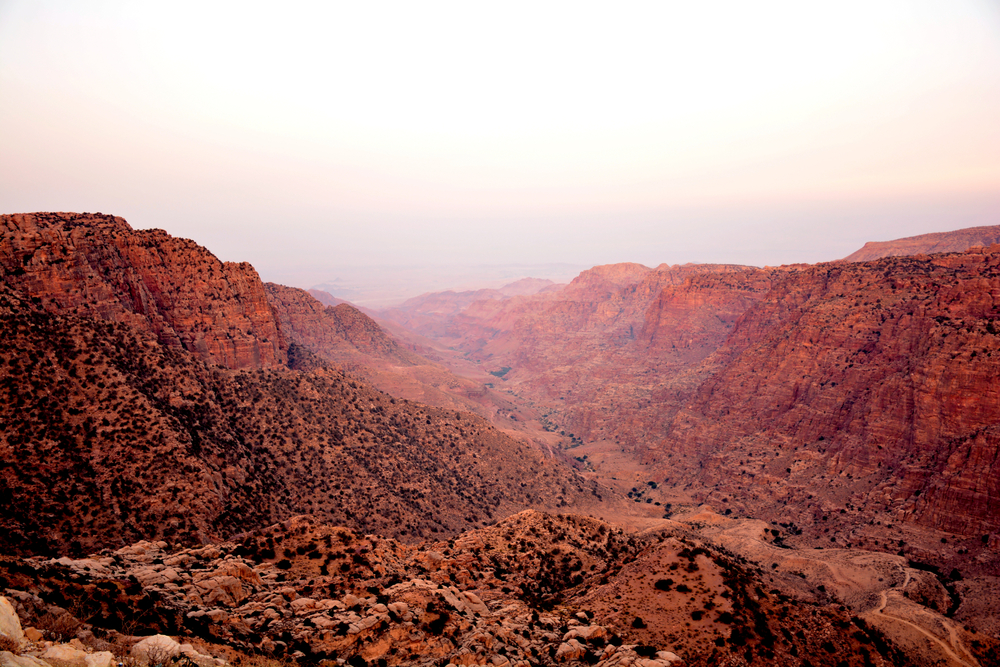
Dana Biosphere Reserve
For a truly immersive experience within Jordan’s natural beauty, you’ll want to head for Dana Biosphere Reserve, the largest reserve in Jordan at 320 square kilometres, which surrounds Wadi Dana as it leads down from the Jordanian Plateau to the Dead Sea. At the head of the valley, Dana village is a traditional settlement which has been rescued from ruin by the Royal Society for the Conservation of Nature (RSCN), one of the most progressive conservation bodies in the Middle East. The organisation helped to resurrect the village and encouraged tourism to the area, helping to provide villagers with jobs. Because of this, the traditional way of life has been preserved, and many of the local people give guided walks around the reserve.
As well as meeting the residents and learning about their customs, it’s also possible to view a variety of rare and protected wildlife, such as the Nubian ibex and sand cat. There are many trails to explore within Dana, such as the Wadi Dana Trail which encircles the head of the magnificent canyon. The trail takes around five to seven hours and can be walked in either direction, but it’s best done downhill as there are several hundred metres elevation change between the start and the finish. En route, you’ll get to look out over the amazing views down the Wadi, as well as across the village’s traditional terraced gardens which supply much of the food for the village.
Along with your local villager guide, you follow a well-defined path through the Wadi. The joys of having an expert guide mean they will be able to point out the wildlife and the historic sights of the Wadi system, such as the old copper workings and Byzantine settlements – the former an interesting side note if you’re feeling fit. The route leads from Dana village to almost sea level at Feynan, where there’s a fabulous lodge also run by the RSCN. Feynan Ecolodge is situated in a rocky amphitheatre and is made almost entirely of traditional materials in the local style, and is powered exclusively by solar – at night, the lighting is provided by candles reflected by shards of mirror and glass.
While the rooms are simply decorated with smooth earthen walls, all have en-suite bathrooms and solar-heated showers, and it’s a restful spot to relax after a long day of walking. If you feel like resting your feet for a day, mountain bikes are available for pedalling through the surrounding hills. What’s almost certain is that there will be very few other visitors in sight.
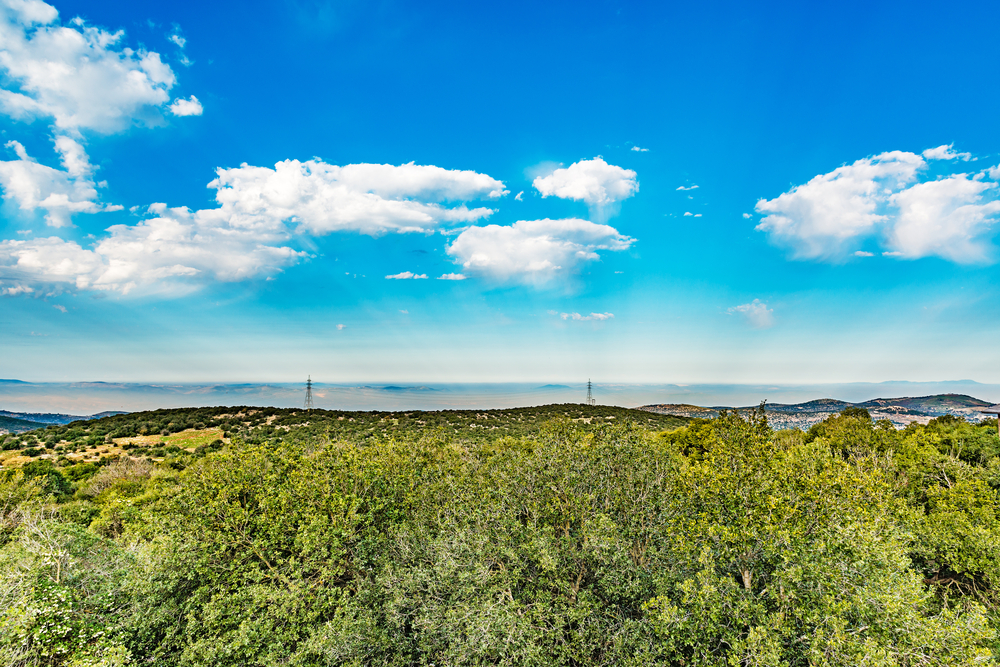
Ajloun Forest Reserve
Also operated by the RSCN is Ajloun Forest Reserve, one of Jordan’s smaller reserves, which offers a totally off-the-beaten-track experience. Staying nearby means bedding down in simple tents or chalets, but this is to best appreciate the proximity to nature. The surrounding countryside is criss-crossed by many beautiful trails. Staying here also offers a novel way to explore some of the area’s big-hitting sights, as Ajloun Castle and Jerash are just a short hop away.
The main draw to this beautiful region is the opportunity to experience Jordan at a slower pace, with the chance to spot many of the elusive wild animals. The plant life here is also quite spectacular, with the trails zipping up and down the sloping hills between fragrant oak, pine and pistachio trees. Many of the trails are self-guided, such as the short route known as the Roe Deer Trail. The guided walk takes you past an ancient stone wine press and offers a good chance to see roe deer – hence the name. The views are curiously similar to the landscapes of England, with rolling green hills and hand-built stone walls. There are very few intrusions from the modern world.
Alternatively, head out on the Orjan Village Trail to explore the orchards and forests. Stopping at a traditional handicraft shop you’ll have the chance to purchase locally-made souvenirs to take home with you. If you want to purchase some soap there’s even a trail for that – the aptly-named Soap Maker’s Trail, which also winds its way through the forest to a soap-manufacturing store.
Most atmospheric of them all is the Prophet’s Trail, which not only makes its way through the forest trails but also pays a visit to the church at Mar Elias, where there are some impressive mosaics. Feeling fit? Head a little further and extend your walk to Ajloun Castle itself, to enjoy beautiful views across the densely forested valley.
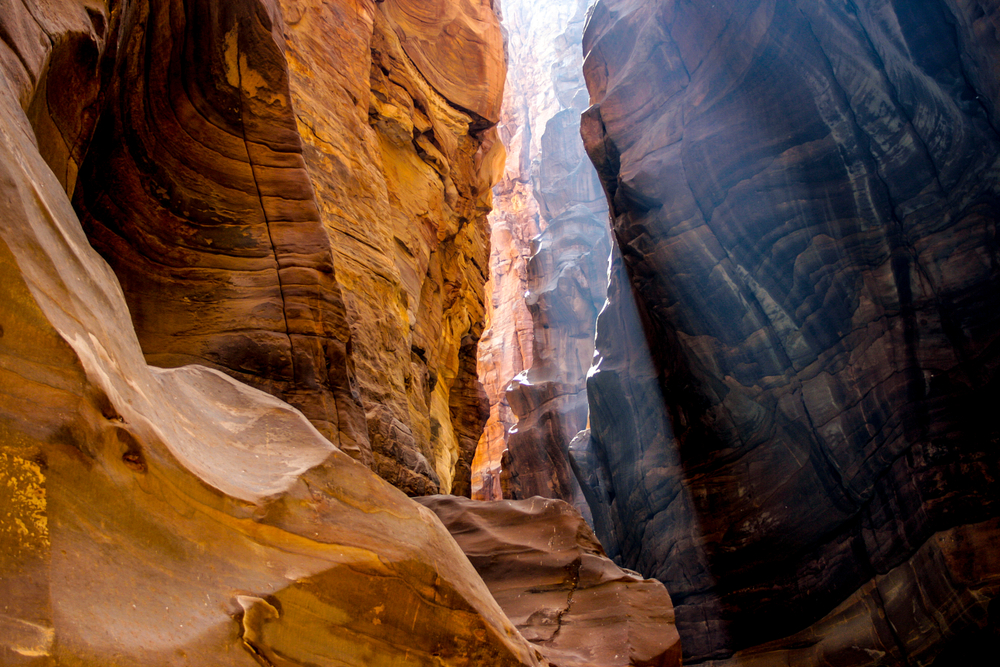
Mujib Biosphere Reserve
Lastly is the Mujib Biosphere Reserve, where there are a huge variety of canyon trails – both guided and self-guided. Your only requirement is to choose how you wish to explore the Mujib Gorge, which will largely depend on your fitness levels and your past experience of hiking. Opt for the easier route and you’ll begin at the King’s Highway, following the road along the edge of the gorge as it seeps away from the plateau to the Dead Sea. There are beautiful views over the natural canyon, the lower portion now filled with water.
Alternatively, those who have good levels of fitness and experience at longer hikes will enjoy the adventurous route, which involves some canyoning – a great way to cool off from the midday heat! At the upper reaches of the trail the walls are steeply-rising and very narrow, with a stream flowing leisurely between. As you scramble down the gorge, you’ll move between the cool rock pools, sliding down the smooth sandstone between each ledge. You’ll definitely want to be prepared to get wet and wear appropriate shoes and clothes for your journey.
Design your own tailor-made Jordan trekking holiday
At the end of your adventure, you’ll want to relax tired limbs, and where better than one of the world’s most famous natural spa resorts? Spend a few days relaxing in one of the luxury hotels along the Dead Sea, indulging in a few treatments and sampling some delicious Jordanian cuisine.
Contact our resident expert Catherine and ask any questions about Jordan trekking holidays or tailor-made trips to view Jordan’s natural beauty, and how to create your own bespoke Jordan holiday.









